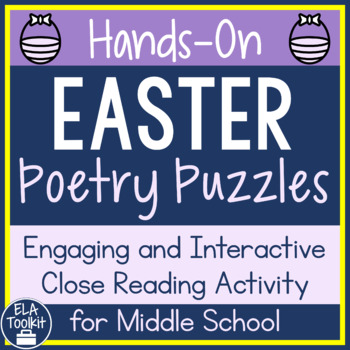Easter Poems Reading Discussion & Analysis | Hands-On Easter Poetry
- Zip
Also included in
- Holiday Poetry Puzzles are a fun, engaging way for students to practice close reading and poetry analysis. Middle school students will be actively engaged in hands-on, interactive collaboration and student-led text-based academic discussions as they read the Easter, Mother's Day, Father's Day, and GPrice $9.00Original Price $12.00Save $3.00
- Poetry Puzzles are a fun, engaging way for students to practice close reading and poetry analysis. Middle school students will be actively engaged in hands-on, interactive collaboration and student-led text-based academic discussions as they read the poems closely, reread, and think critically, workPrice $18.00Original Price $36.00Save $18.00
Description
Easter Poetry Puzzles are a fun, engaging way for students to practice close reading and poetry analysis. Your middle school students will be actively engaged in hands-on, interactive collaboration and student-led text-based academic discussions as they read the Easter poems closely, reread, and think critically, working together to assemble the puzzle pieces in the correct order.
★ GET MORE FOR LESS ★ with this Growing Bundle of Poetry Puzzles!
WHAT'S INCLUDED
• 90 Poetry Puzzle Pieces with lines from 5 Easter poems (see below)
• Differentiated: Each poem is divided into 4, 6, or 8 pieces
• No Prep: Printed in a mixed-up order so students can cut them out
• Answer Key: Links to full text of all poems on reputable ad-free websites
• Editable Teaching Slides with student directions and the list of Easter poems
• User-friendly Teacher's Guide with detailed lesson plan, differentiation, variations, and extensions
EASTER POEMS
• Easter Eggs by Mark Anderson
• Easter Wings by George Herbert
• The Easter Flower by Claude McKay
• Not Ideas About the Thing But the Thing Itself by Wallace Stevens
• Gulls by William Carlos Williams
⇒ Looking for more challenging poems? Click here for the high school version!
HOW IT WORKS
The Easter Poetry Puzzle activity helps students develop the habits and skills of close reading by requiring them to:
• Reread their poems multiple times
• Examine the poem’s diction and syntax closely
• Peel back the layers to uncover what the poem says, how the poem says it, and what the poem means
• Engage in deep text-based discussions
• Point to specific words and meanings in the poem as they justify and provide a rationale for their sequencing of the poetry pieces
WHY POETRY PUZZLES?
• These short Easter poems are ideal complex texts for close reading practice.
• Students are motivated and engaged by the collaborative and puzzle solving aspects of the activity as they work together to figure out how to construct their poems.
• Students reread and closely analyze the text to determine what their individual poetry pieces mean and how those lines come together to convey the overall meaning of the poem.
• There are several options for organizing the activity. You can have everyone assembling the same poem or have each group putting together a different poem. Students can also work with more than one poem at a time.
• The extension activities provide opportunities for students to practice paraphrasing, creating visual images to enhance communication, and reading aloud with fluency and expression.
COMMON CORE AND TEKS ALIGNED
• CCSS.CCRA.R.1 Read closely to determine what the text says explicitly and make logical inferences from it; cite specific textual evidence
• CCSS.CCRA.R.4 Interpret words and phrases as they are used in a text
• CCSS.CCRA.R.5 Analyze the structure of texts, including how ... stanzas relate to each other and to the whole
• TEKS.LA.6-8.5.F Make inferences and use evidence to support understanding
• TEKS.LA.6-8.6.C Use text evidence to support an appropriate response
___________________________________________
RELATED RESOURCES
• Hands-On Activities
• Poetry Resources
• Discussion Resources
___________________________________________
➼ Get Half Price and FREE Resources! ★ CLICK HERE ★ to follow my store and hear about sales, freebies, and new resources, which are always 50% off for the first 48 hours!
➼ Earn TpT Credits! ★ CLICK HERE ★ to leave a review and earn credits to use on future TpT purchases.
Thank you for visiting the ELA Toolkit store! Please contact me if you have any questions or requests.
Take care, Honor @ ELA Toolkit







